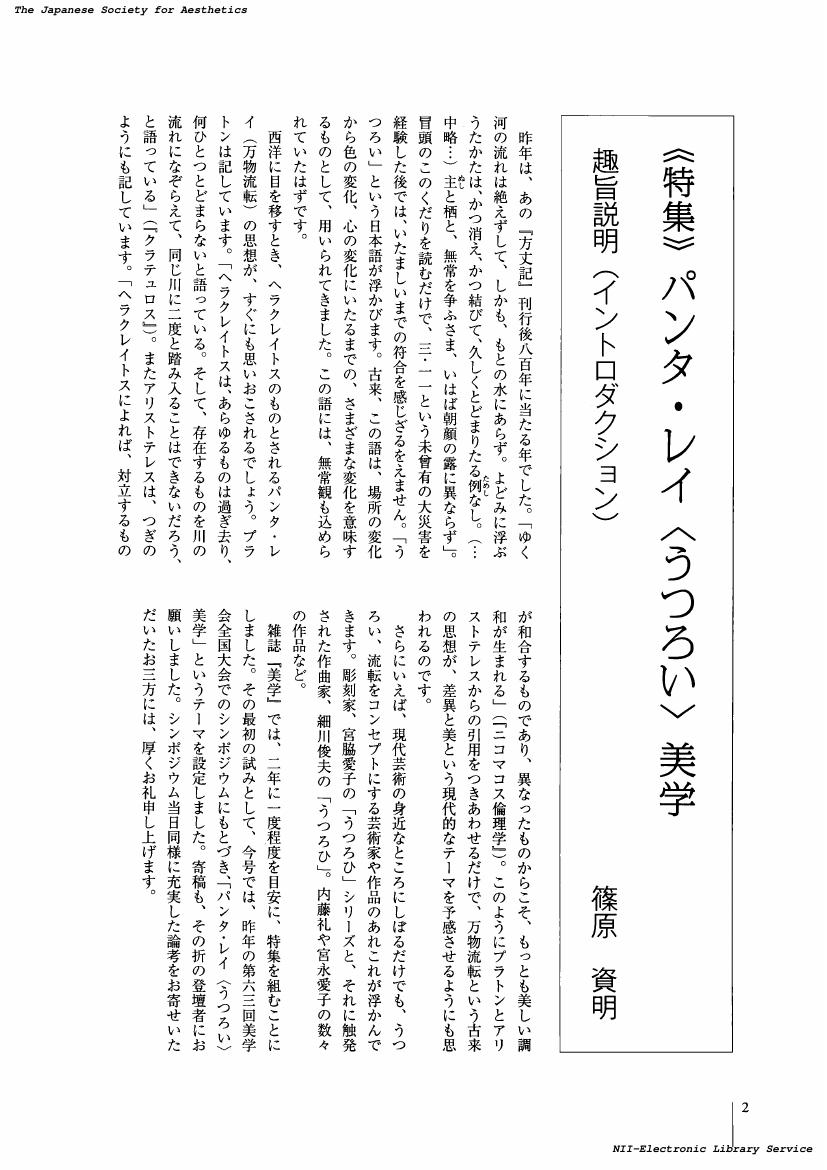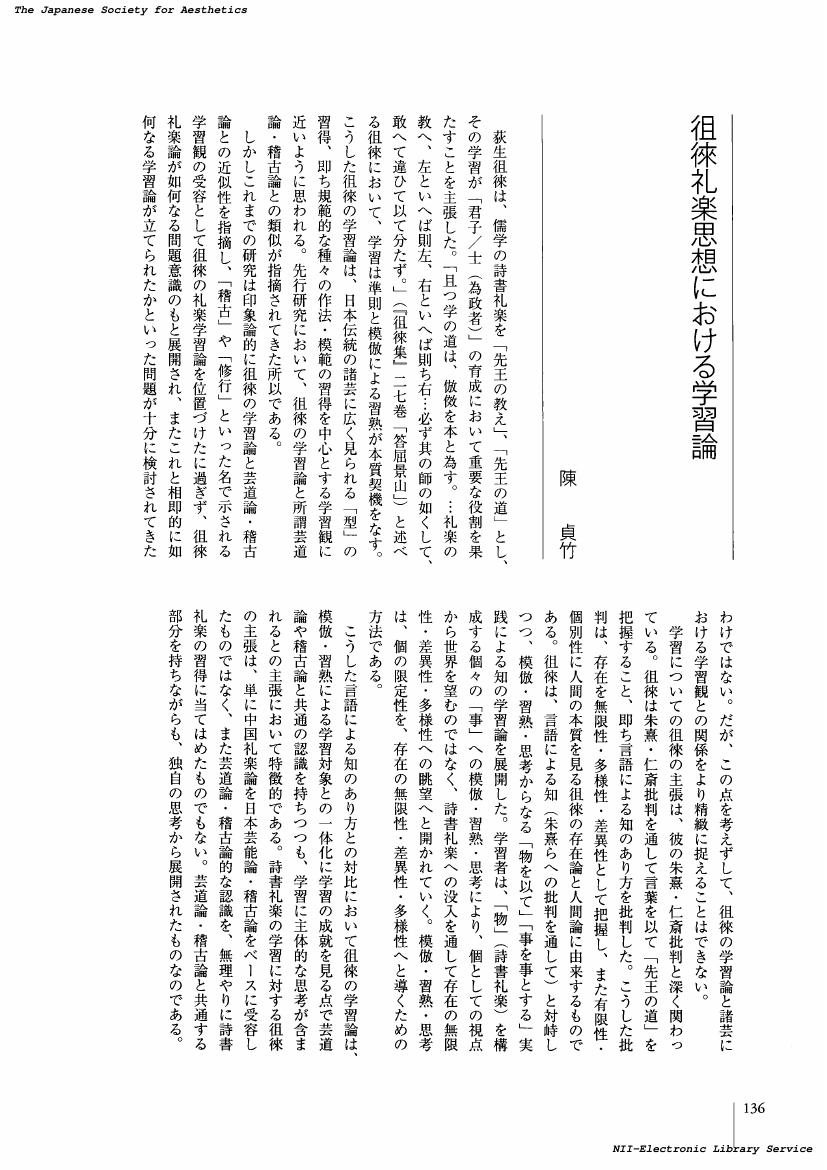- 著者
- 吹田 映子
- 出版者
- 美学会
- 雑誌
- 美学 (ISSN:05200962)
- 巻号頁・発行日
- vol.64, no.1, pp.131-142, 2013-06-30 (Released:2017-05-22)
In 1938 Rene Magritte delivered an autobiographic lecture entitled "The Lifeline." This lecture has been discussed exclusively in terms of his new principle of creation which was to seek an image based on the affinity of two objetcs by using the "question-answer" method. This paper elucidates Magritte's use of the motif of light and shade by comparing several versions of the text of the lecture with related paintings. The comparison reveals that, when Magritte prepared the lecture, he considered light and shade as his crucial motif and attempted to gain more insight of them through an analysis of visibility and life. In the lecture Magritte defined the image he had seen in a cemetery in his childhood as "the image found in the light going through the shade" which was related with his intuition of the affinities of objects. Such comprehension of images resulted from the principal motive of his creation that is to grasp the whole "life". This vision produced The Beyond (1938) and works after the 1940's.
1 0 0 0 OA ロンドン国際シュルレアリスム展(一九三六年)にみる相隔たるもの同士の並置をめぐる諸問題
- 著者
- 石井 祐子
- 出版者
- 美学会
- 雑誌
- 美学 (ISSN:05200962)
- 巻号頁・発行日
- vol.64, no.1, pp.143-154, 2013-06-30 (Released:2017-05-22)
In June 1936, a large international surrealist exhibition was held in London at the New Burlington Galleries. Although this exhibition did not have strategy to produce "marvellous" exhibition space, it still reflected surrealistic method in some ways. Its method was "the juxtaposition of mutually distant objects" which was related to the idea of collage cultivated in surrealism especially in 1930's. This paper, therefore, analyses the process of organizing the London exhibition, and makes it clear how this collage related method was expanded in the exhibition. In the mid-1930s, surrealist ideas as well as "semantic collage" crossed the international borders and spread to various media including exhibition. In the London exhibition, there are some examples based on this idea; a way of display and a catchphrase planned for its advertisement. These cases showed this method had been diversified through expansion and internationalisation of surrealist movement in this period, while they also revealed slight differences from the original idea. In this way, the London exhibition is not only one of the milestones in the history of international surrealist exhibitions, but also an early example concerning the issue of diffusion and reception of surrealism.
- 著者
- 上村 博
- 出版者
- 美学会
- 雑誌
- 美学 (ISSN:05200962)
- 巻号頁・発行日
- vol.64, no.1, pp.26-34, 2013-06-30 (Released:2017-05-22)
This article aims to point out the change of our sensibility towards fluidity occurred about 1900. The motifs of fluidity in art, especially that of water and the serpent (snake), connected with the figure of woman, were already motifs to represent an undomesticated evil character and an object of desire. But through the 19^<th> century, new attitude appeared. The water is observed scientifically, and the linea serpentina became thread conductor which reveals us the mystery of the material world. Even the figure of femmefatale, a traditional misogynistic image, has its new type in that of femme-enfant, attractive but incommunicable as the matter. In fact, with the discoveries such as that of electro-magnetic waves, the matter had changed its image, from a solid moving in the vacant space to the fluidity extended that has no real contours. The aether, a substance interpreted variously, symbolizes this universal continuity. The fluid matter, old symbol of ephemeral life, has become symbol of the mystic nature. Our aesthetic experience has been oriented to this subtle existence, and ponder in the exquisite perception of change.
1 0 0 0 OA 瞬間と持続 : 写真とベルクソニスム
- 著者
- 大石 和久
- 出版者
- 美学会
- 雑誌
- 美学 (ISSN:05200962)
- 巻号頁・発行日
- vol.64, no.1, pp.35-46, 2013-06-30 (Released:2017-05-22)
Henri Bergson states that "duration", which cannot be fragmented into instants, has reality, and that the instants themselves are unreal. Herein lies the difficulty of discussing the photograph from a Bergsonist viewpoint. To solve this problem, this paper proposes that Bergson treats the "any-instant-whatever" as a kind of duration, but one which is without memory, and is therefore extremely expanded. In contrast, subjective human perception is a condensing of myriads of instants via the memory, and is therefore a contracted duration. Without memory, the any-instant-whatevers return to themselves, and become objective. This paper proposes that the camera, being only physical matter without human memory, reveals the any-instant-whatever that had become indistinguishable in the contracting memory. From this viewpoint, the photograph is objective in its instantaneity, revealing instantaneous "differences" that are "useless" for human beings; Bergson recognizes that "revelation" is a function of art. Thus, the "optical unconscious" revealed instantaneously by the photograph, refers not to psychological reality, but to the objective (material) world.
1 0 0 0 OA パース思想を踏まえた「芸術の人類学」の展開可能性
- 著者
- 加藤 隆文
- 出版者
- 美学会
- 雑誌
- 美学 (ISSN:05200962)
- 巻号頁・発行日
- vol.64, no.1, pp.47-58, 2013-06-30 (Released:2017-05-22)
This paper is an attempt to suggest a provoking theory about actions of human beings (including art-creating actions, art-appreciating actions, etc.). With this aim, I refer to Alfred Gell's posthumous book, Art and Agency (AA hereinafter), especially focusing on his concepts of 'agency' and 'index'. Because 'index' is a concept derived from C. S. Peirce's semiotics, Gell's theory may also imply a kind of applicability of Peirce's idea, though Gell's 'index' is not necessarily compatible with Peirce's. In Gell's terminology, 'index' is an object that mediates 'agency'. What he argues is that 'agency' can be attributed to not only persons but also things such as god statues as long as they (persons and things) are seen as initiating causal sequences caused by some sort of intention. Utilizing these concepts, Gell puts forward 'Anthropology of Art'. He suggests that art objects should be anthropologically examined in order to grasp their 'behaviour' (AA, p.11) in the context of social relations. In this paper, above all I remark on Gell's unique idea The Extended Mind', which is also the title for the last chapter of AA. Interestingly, according to this idea, artworks (and artefacts) and persons can be regarded analogously as 'indexes' embodying collective consciousness of social agents.
- 著者
- 内藤 李香
- 出版者
- 美学会
- 雑誌
- 美学 (ISSN:05200962)
- 巻号頁・発行日
- vol.64, no.1, pp.59-70, 2013-06-30 (Released:2017-05-22)
Das Charakteristische an der Musiktheorie von Adorno ist, dass die Musik im Zusammenhang mit der Gesellschaft betrachtet wird. In diesem Aufsatz wird versucht, anhand der Neugestaltung der Musikblatter des Anbruch durch Adorno im Jahre 1928, dessen Ideologiekritik konkret darzulegen. Der Text "zum Anbruch" als Quelle dienend, werden die drei folgenden Probleme, die Adorno in seiner Neugestaltung prasentiert, untersucht. 1) Der Anbruch sollte von einem Propagandaorgan in eine musikpolitische Zeitschrift verwandelt werden. 2) Um 1) durchzufuhren ist es notwendig, dass der Anbruch durch die kritische Beurteilung der neoklassizistischen Musik als reaktionare Musik Aufschluss gibt uber seine ideologische Seite, die einen nur scheinbar aktuellen Charakter besitzt. 3) Im Anbruch sollen die Probleme im Zusammenhang mit Radio, Kino-Musik and leichter Musik als in hochstem Masse soziologische Probleme betrachtet werden. Das Problem besteht darin, dass die scheinbare Popularitat des Kitsch einen ideologischen Charakter besitzt. Von diesem Prozess des Denkens um die Neugestaltung wird das Urbild der Ideologiekritik Adornos gefunden.
- 著者
- 岡田 温司
- 出版者
- 美学会
- 雑誌
- 美学 (ISSN:05200962)
- 巻号頁・発行日
- vol.63, no.2, pp.159, 2012-12-31 (Released:2017-05-22)
1 0 0 0 OA 趣旨説明(イントロダクション)(<特集>パンタ・レイ<うつろい>美学)
- 著者
- 篠原 資明
- 出版者
- 美学会
- 雑誌
- 美学 (ISSN:05200962)
- 巻号頁・発行日
- vol.64, no.1, pp.2, 2013-06-30 (Released:2017-05-22)
1 0 0 0 OA 移ろいの詩学 : 回帰と転移(<特集>パンタ・レイ<うつろい>美学)
- 著者
- 尼ヶ崎 彬
- 出版者
- 美学会
- 雑誌
- 美学 (ISSN:05200962)
- 巻号頁・発行日
- vol.64, no.1, pp.3-14, 2013-06-30 (Released:2017-05-22)
Roman Jacobson defined the poetic function in "Linguistics and Poetics" as follows. "The poetic function projects the principle of equivalence from the axis of selection into the axis of combination". He thought that the essence of poetic composition lies in repetition and demonstrated that parallelism is the necessary condition of poetry in many folks. Though tanka (short verse), the representative form of Japanese poetry, has scarcely repetition. Japanese much loved the parallelism in Chinese poetry and Japanese prose, but excluded it from tanka. Ancient tanka poets juxtaposed two equivalent words not only to produce repetition but also to change the topics. After 10th century poets mainly made use of them to change topics by fusing two words into one dual meaning word or paronomasia (kake-kotoba). For example, a tanka starts with mentioning love, shifts to describing scenery, then ends expressing love again. This verse is composed not by three sentences, but by one sentence with two paronomasia. Readers will enjoy twice transitions like going out and coming back through a revolving door. An unexpected experience of transition is found in various fields of Japanese art. Such as emakimono (picture scroll), Japanese stroll gardens, and especially renga (chained tanka) offer the transition as their key element of artistic effects.
- 著者
- 岡本 源太
- 出版者
- 美学会
- 雑誌
- 美学 (ISSN:05200962)
- 巻号頁・発行日
- vol.64, no.1, pp.15-25, 2013-06-30 (Released:2017-05-22)
Selon Erwin Panofsky, c'est a la Renaissance qu'est apparue l'idee de temps <<destructeuro>>, Kronos, represents par la figure d'un vieillard ails avec ses attributs sinistres: la faux, un corps decharne, etc. Cette idee correspond, semble-t-il, a la nouvelle sensibilite a l'egard de la vicissitude des choses, comme on peut le voir notamment darts les traites d'art de l'epoque. Dans cette optique, j'examine l'esthetique de Leon Battista Alberti (1404-1472) a l'aube de la Renaissance puis a sa fin, de Giordano Bruno (1548-1600). A relire leurs comedies telles que le Momus d'Alberti ou bien le Candelaio de Bruno, on percoit immediatement qu'ils montrent avec ironie comment les hommes ou encore les dieux ignorent l'instabilite du temps a cause de l'apparence trompeuse d'une permanence des choses. De ce point de vue, l'art ne semble etre qu'une fiction trompeuse. Mais, en meme temps, ces auteurs donnent a l'art un nouveau statut: Alberti suggere que la peinture est une forme du savoir prete a detroner la vieille philosophie, Bruno identifie la vraie peinture avec la vraie philosophie. Le nouveau statut de l'art face aux vicissitudes des choses est etroitement lie a l'argumentation albertienne sur l'ornamentum et au concept brunien de vinculum.
- 著者
- 裴 泰秀
- 出版者
- 美学会
- 雑誌
- 美学 (ISSN:05200962)
- 巻号頁・発行日
- vol.63, no.2, pp.153-154, 2012-12-31 (Released:2017-05-22)
- 著者
- 加藤 哲弘
- 出版者
- 美学会
- 雑誌
- 美学 (ISSN:05200962)
- 巻号頁・発行日
- vol.63, no.2, pp.155, 2012-12-31 (Released:2017-05-22)
- 著者
- 瀧川 美生
- 出版者
- 美学会
- 雑誌
- 美学 (ISSN:05200962)
- 巻号頁・発行日
- vol.63, no.2, pp.156, 2012-12-31 (Released:2017-05-22)
- 著者
- 川瀬 智之
- 出版者
- 美学会
- 雑誌
- 美学 (ISSN:05200962)
- 巻号頁・発行日
- vol.63, no.2, pp.157, 2012-12-31 (Released:2017-05-22)
- 著者
- 鎌田 由美子
- 出版者
- 美学会
- 雑誌
- 美学 (ISSN:05200962)
- 巻号頁・発行日
- vol.63, no.2, pp.147, 2012-12-31 (Released:2017-05-22)
- 著者
- 大石 昌史
- 出版者
- 美学会
- 雑誌
- 美学 (ISSN:05200962)
- 巻号頁・発行日
- vol.63, no.2, pp.148, 2012-12-31 (Released:2017-05-22)
- 著者
- 岡林 洋
- 出版者
- 美学会
- 雑誌
- 美学 (ISSN:05200962)
- 巻号頁・発行日
- vol.63, no.2, pp.149-150, 2012-12-31 (Released:2017-05-22)
- 著者
- 小林 信之
- 出版者
- 美学会
- 雑誌
- 美学 (ISSN:05200962)
- 巻号頁・発行日
- vol.63, no.2, pp.151, 2012-12-31 (Released:2017-05-22)
- 著者
- 松尾 大
- 出版者
- 美学会
- 雑誌
- 美学 (ISSN:05200962)
- 巻号頁・発行日
- vol.63, no.2, pp.152, 2012-12-31 (Released:2017-05-22)
1 0 0 0 OA 徂徠礼楽思想における学習論(第六十三回美学会全国大会発表要旨)
- 著者
- 陳 貞竹
- 出版者
- 美学会
- 雑誌
- 美学 (ISSN:05200962)
- 巻号頁・発行日
- vol.63, no.2, pp.136, 2012-12-31 (Released:2017-05-22)











